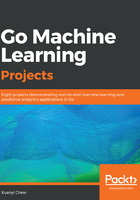
What this book covers
Chapter 1, How To Solve All Machine Learning Problems, introduces two classes of machine learning: regression and classification. By the end of this chapter, you should feel comfortable with the data structures used to build machine learning programs. Most machine learning algorithms are built based on the data structures introduced here. We are then going to introduce Go machine learning and get you up and running for further projects.
Chapter 2, Linear Regression – House Price Prediction, goes into a regression analysis on a real-life dataset on house pricing. We will start off by building the necessary data structures to perform such analyses, along with initial exploration of the dataset.
Chapter 3, Classification – Spam Email Detection, covers the construction of a classification model in Go. The dataset is the classic spam and ham email dataset in which our goal is to build a model that classifies the emails as spam or ham. Then, we will learn how to write the algorithms themselves, while leveraging external libraries (such as Gonum) for data structure support.
Chapter 4, Decomposing CO2 Trends Using Time Series Analysis, introduces us to the subtleties of time series analysis. Data in time series can often be decomposed for descriptive purposes. This chapter shows us how to perform such decompositions, and how to display them using Gonum's plotting tools as well as gnuplot.
Chapter 5, Clean Up Your Personal Twitter Timeline by Clustering Tweets, covers the clustering of tweets on Twitter. We will be using two different clustering techniques, K-Means and DBSCAN. For this chapter, we're going to rely on a number of skills we built up in Chapter 2, Linear Regression – House Price Prediction. We will also be using the same libraries used in the aforementioned chaper. On top of that, we will also be using the clusters library by Marcin Praski
Chapter 6, Neural Networks – MNIST Handwriting Recognition, opens up the rich world of image recognition to us. Images are difficult, because useful features are nonlinear products of the input features. The aim of this project is to introduce the various methods of handling high-dimensional data; specifically, the use of PCA algorithms in the Gonum library to whiten data.
Chapter 7, Convolutional Neural Networks – MNIST Handwriting Recognition, explains how to use recent advancements in deep learning to perform handwriting recognition, by building a convolutional neural network using Gorgonia tp achieve 99.87% accuracy.
Chapter 8, Basic Facial Detection, explores a basic implementation of facial detection. By the end of this chapter, we will have implemented a usable facial detection system using GoCV and PIGO. This chapter teaches an important lesson in learning to choose the correct algorithm for the job.
Chapter 9, Hot Dog or Not Hot Dog - Using External Services culminates the book by showing how one may integrate external services in machine learning projects, and what to look out for when doing so.
Chapter 10, What Is Next, lists the further avenues for machine learning in Go.